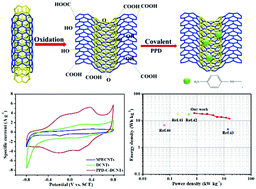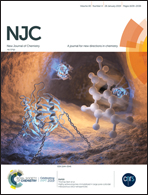Covalently functionalized heterostructured carbon by redox-active p-phenylenediamine molecules for high-performance symmetric supercapacitors
Abstract
As a new type of green electrode material for supercapacitors, redox-active organic molecules have shown great potential due to their fast and reversible redox reactivity, excellent cycle stability and sustainability. However, their electrically insulating nature limits any practical application when they are used alone. Herein, dissected carbon nanotubes (DCNTs) were prepared through a single-step chemical oxidation method to build a unique conductive substrate with 1D nanotubes and 2D graphene nanoribbons. Also, thanks to the abundant oxygen-containing functional groups on the sidewalls of DCNTs, redox-active organic p-phenylenediamine (PPD) molecules can be strongly and massively anchored by a covalent strategy. In this design, DCNTs can serve as a conductive network to ensure efficient electron transport while PPD molecules guarantee a high specific capacitance via the fast and reversible redox reaction. Under the synergy of the two parts, the PPD covalently functionalized DCNT (PPD-C-DCNT) electrode material displays a high capacitance value of 388 F g−1 at 1 A g−1 (ten times higher than that of pristine MWCNTs), a wide electrochemical stable potential window of −0.8 to 0.8 V vs. the SCE reference electrode in 1 mol L−1 H2SO4 and an outstanding electrochemical stability of 85.7% after 10 000 cycles at 5 A g−1. Finally, a novel symmetric supercapacitor (PPD-C-DCNT SSC) was assembled to evaluate the actual energy storage properties of the electrode material. As a result, the PPD-C-DCNT SSC exhibits a maximum energy density of 19.1 W h kg−1 at a power density of 800 W kg−1 in a cell voltage ranging from 0 to 1.6 V.



 Please wait while we load your content...
Please wait while we load your content...